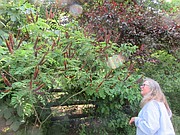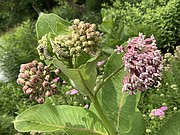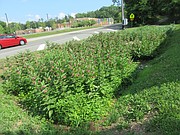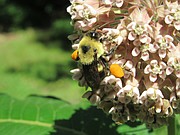Tuesday, July 20, 2021
When Tami Entabi moved into her Mount Vernon-area home in 2006, the backyard was a thick mass of intertwined English ivy. Today, to her delight, purple violets are spreading and the garden is abuzz with birds, bees, butterflies, moths and other insects from spring through fall.
Entabi removed most of the English ivy, an invasive plant, and wants the violets to take over. They support the great spangled fritillary butterfly and provide nectar plants for other pollinators. She’s striving for blooms most of the year. She leaves the leaves and dead wood in her garden beds. Her goal is a woodland garden of native plants that supports native insects, birds and other wildlife.
Entabi and many others are trying to eliminate plants not native to the area. Non-native or invasive plants are plants introduced to an area intentionally or accidentally. Many spread rapidly and lack natural controls. They usually outcompete native plants, alter biological communities and degrade natural ecosystems. Some can cause economic harm.
Trouble Signs
The Earth is losing one to two percent of its insects every year, reported University of Connecticut entomologist David Wagner in January, a trend some call “the insect apocalypse.” NatureServe scientists estimate that about one third of all U.S. species of animals and vascular plants are at risk of extinction. A 2020 World Wildlife Fund study found that of nearly 4,400 mammals, amphibians, birds, fish and reptile populations have dropped by 68 percent since 1970.
These studies are signaling that the way we are managing or failing to manage our natural resources is having serious consequences. Experts point to habitat loss and fragmentation, monocultures, invasive species, pesticides, herbicides, insecticides, climate change, light pollution and disease as contributing factors.
In suburbia, lawns and sprawling development have replaced most native biodiversity. Lawns cover 40 to 50 million acres of land in the United States, almost equivalent to all of the country’s national parks, wrote Tik Root in the July 1 Washington Post. Lawns and turfgrass are the largest “crop” grown in the Chesapeake Bay watershed. And while the perfect green lawn may be an American icon, ecologically, it has very little habitat value.
To reverse the declines in insects, birds and other wildlife and to be better stewards of the environment, many gardeners today are turning to more natural landscaping approaches and native plants.
University of Delaware entomologist Dr. Doug Tallamy offers this: “We have allowed alien plants to replace natives all over the country. Our native animals and plants cannot adapt to this gross and completely unnatural manipulation of their environment in time to negate the consequences.”
With his initiative called “Homegrown National Park,” Dr. Tallamy argues that our national parks are too small and spread apart to preserve species to the levels needed, that people can restore habitat and the ecological health of our communities.
Examples: Mount Vernon Supervisor Dan Storck and volunteers converted part of the landscape around the Mount Vernon Government Center to native plants. He led an effort started in 2018 and adopted unanimously by the Board of Supervisors in 2020 to apply natural landscaping practices to county properties. Belle View Elementary School teachers created a native garden, outdoor classroom.
Pollinator Gardening
Pollinators include bees, beetles, butterflies, moths, other insects, birds and bats. When a pollinator carries pollen grains from the male anther of a flower to the female stigma of flowers of the same species and fertilizes it, pollination results and the plant can produce seeds. Around 75 percent of all flowering plants depend on pollinators for fertilization, but many pollinator species are declining. “The main threat facing wild pollinators Is loss of habitats,” wrote Kathy Reshetiloff for the Bay Journal.
Some pollinators are generalists and can pollinate a variety of plant species, but others are highly specialized. Many pollinators evolved to emerge when their plants are flowering. If the plants are not available, the pollinators cannot survive.
In Entabi’s backyard, coreopsis plants attract skipper and fritillary butterflies. Hummingbirds probe coral honeysuckle blossoms. Luna moths visit the pignut hickory trees. Zebra swallowtail butterflies visit the pawpaw trees. Their caterpillars feed at night and spend the day in the leaf litter. Bees love the St. Johnswort. Many insects feed on the goldenrod. Woodpeckers excavate dead wood. Skinks hide out in brush piles. Where a big tree that came down left a big hole, Entabi’s making a frog pond. “The soft bottom will be good for hibernating and the trunk will be part of pond and offer places to hide,” she says.
Butterfly Gardening
Some people are planting native plants to support butterflies. “Selecting plants that will feed butterflies while also encouraging them to stick around for a while, laying eggs and creating a new generation of butterflies is your goal,” advises the North American Butterfly Association’s website. “To do this, you will need to choose plants that fall into two groups: nectar plants that will provide adult butterflies with energy and caterpillar food plants that will feed caterpillars. With careful selection from these two groups, your garden will provide for the entire life cycle of butterflies.”
Some people are planting to specifically help monarch butterflies and support their migration to and from Mexico. These orange and black butterflies, weighing one-fifth the weight of a penny, are the only butterfly species to regularly undertake a two-way migration, for some, a 3,000-mile trip over three generations. “This is one of the most extraordinary annual migrations on our planet,” said monarch expert, the late Dr. Lincoln Brower of Sweet Briar College.
Most butterfly caterpillars feed on specific plant species, called their host plant. Monarch butterfly caterpillars feed exclusively on milkweed leaves. Host plants generally are the plants on which butterflies lay eggs and their caterpillars eat. Without milkweed, monarch butterflies cannot complete their life cycle.
The American Horticultural Society’s River Farm, Fort Belvoir and Burgundy Farm Country Day School have monarch butterfly gardens. The Martha Washington Library has a milkweed garden.
Tallamy urges people to “re-create” nature. For species in decline, he says, “Their only hope for a sustainable future is for us to intervene to right the wrongs that we have perpetrated. In order to let nature take its course, we must first re-create nature.”
Tami Entabi’s backyard is a good example.
“On your own property you can make a difference,” Entabi says. “It’s exciting.”
Resources
Pollinator Gardening, www.pollinator.org; www.xerces.org/bringbackthepollinators
Butterfly Gardening, http://nababutterfly.com/basics-of-butterfly-gardening/
Guide to Native Plants for Northern Virginia, https://www.plantnovanatives.org/
Wildlife Habitat Gardens: Audubon at Home, www.audubonva.org,
https://www.nwf.org/CertifiedWildlifeHabitat;
Habitat at Home, https://dwr.virginia.gov/wildlife/habitat/
“Nature's Best Hope: A New Approach to Conservation That Starts in Your Yard,” book by Douglas W. Tallamy



